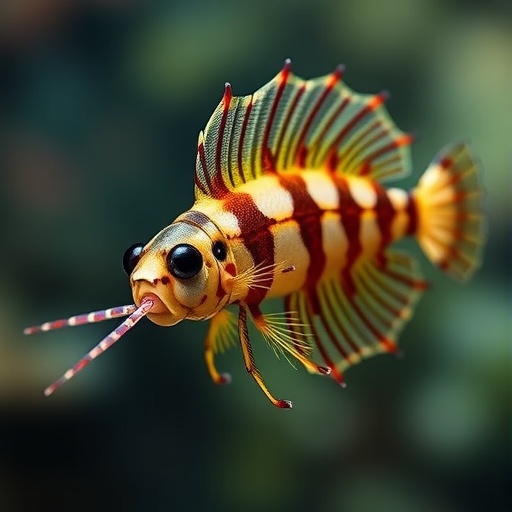In a groundbreaking exploration of the genetic underpinnings of one of Asia’s unique freshwater fish species, recent research has illuminated the evolutionary adaptations and genetic structures of Schizopygopsis malacanthus, a fish endemic to China’s Jinsha and Yalong rivers. These findings, which emerged from a comprehensive genomic study, were spearheaded by researchers who sought to decode the complexities tied to this species in a rapidly changing environmental context. The research invokes a stronger understanding of how specific genetic traits facilitate survival in diverse aquatic environments.
The study reveals that Schizopygopsis malacanthus not only boasts a remarkable capacity to adapt to distinct ecological niches but also serves as a crucial indicator species for the overall health of freshwater ecosystems within its native range. As the pressures from pollution, climate change, and habitat loss intensify, understanding the genetic basis of resilience in this species could have significant implications for conservation strategies. Through advanced genomic sequencing technologies, researchers could clarify the genotype-phenotype relationships that are key to the fish’s adaptability.
Notably, the researchers conducted an extensive sampling campaign across the Jinsha River and Yalong River basins to collect individuals from various habitats, ensuring that the genetic diversity of populations was adequately represented. The data derived from these populations provided critical insights into the demographic history and structure of the species. Importantly, findings suggest a differentiation in genetic lineages that is likely driven by the varying ecological conditions across the sampled sites, confirming the influence of local environmental factors on genetic diversity.
The genomic data revealed several intriguing aspects of the fish’s evolution. For instance, analyses identified specific genes associated with adaptive traits such as osmoregulation, temperature tolerance, and dietary flexibility. These traits are particularly crucial for a species that inhabits diverse riverine environments. The uncovering of these genetic adaptations underlines the importance of genomic research in understanding the resilience of a species in the face of anthropogenic changes.
Moreover, the research unveiled remarkable evolutionary signatures that indicate historical patterns of gene flow and isolation among populations. Such demographic dynamics can shape the genetic landscape and influence the potential for future adaptations. By employing population genomics techniques, the team successfully mapped out the genetic structure that defines these populations, allowing for a clearer picture of how they may respond to ongoing environmental change.
The findings of this research carry profound implications for conservation biologists and policymakers who are tasked with preserving freshwater biodiversity. Recognizing the unique genetic characteristics of Schizopygopsis malacanthus could inform targeted conservation efforts aimed at safeguarding both the species and its habitat. Furthermore, educating the public on the significance of riverine ecosystems and their resident species can engender broader support for conservation initiatives.
In the context of fisheries management, the insights gained from this genomic study offer a pathway to more sustainable practices. As fish populations face increased fishing pressures and habitat degradation, understanding the genetic traits that confer resilience can aid in formulating strategies that promote the health and viability of fish stocks. This data-driven approach fosters a more balanced interaction between human activity and natural ecosystems.
Researchers also highlighted the implications of their findings for future scientific investigations. The approach taken in this study can serve as a model for examining the genetic structure of other endangered or economically significant fish species in various aquatic environments worldwide. By employing similar genomic techniques, collaborative research can ultimately contribute to a greater understanding of biodiversity and resilience across global fish populations.
As more research surfaces that delves into the genetic complexities of aquatic species, the field of conservation genetics will only continue to evolve. Collaborative efforts among scientists, policymakers, and conservationists exemplify the multidisciplinary approach needed to address the challenges faced by freshwater ecosystems today. The hope is that this study will inspire further research, catalyzing a comprehensive effort to protect and understand the rich biodiversity that freshwater systems harbor.
In conclusion, the work conducted by Yan, Gao, He, and their colleagues underscores the profound connection between genetic diversity and environmental adaptability in species like Schizopygopsis malacanthus. Their findings promise not only a better understanding of this specific fish’s evolutionary journey but also point toward critical conservation strategies that could bolster the resilience of freshwater biodiversity. As the global community confronts the mounting challenges of environmental change, it is through the lens of such research that proactive measures can be shaped to safeguard both the species and their habitats.
Through continued exploration of the genetic factors that underpin the survival of aquatic species, there lies a potential to reshape the narrative of conservation. The pursuit of understanding these connections will remain ever more vital as we strive to maintain the equilibrium of our freshwater ecosystems, essential not only for the species that inhabit them but also for the myriad human communities that depend on these natural resources.
Subject of Research: Genetic structure and adaptive characterization of Schizopygopsis malacanthus
Article Title: Genomic-based revelation of genetic structure and adaptive characterization of Schizopygopsis malacanthus in the Jinsha River and Yalong River.
Article References:
Yan, T., Gao, K., He, L. et al. Genomic-based revelation of genetic structure and adaptive characterization of Schizopygopsis malacanthus in the Jinsha River and Yalong River.
BMC Genomics 26, 870 (2025). https://doi.org/10.1186/s12864-025-12065-z
Image Credits: AI Generated
DOI: 10.1186/s12864-025-12065-z
Keywords: Schizopygopsis malacanthus, genetics, adaptability, conservation, freshwater ecosystems, population genomics, evolutionary biology, environmental change.
Tags: advanced genomic sequencing technologiesChina endemic speciesclimate change resilience in fishconservation geneticsecological niche adaptationfreshwater ecosystem conservation strategiesfreshwater fish genomicsgenotype-phenotype relationshipsJinsha River biodiversitypollution impact on freshwater speciesSchizopygopsis malacanthus genetic adaptationYalong River ecosystem health





